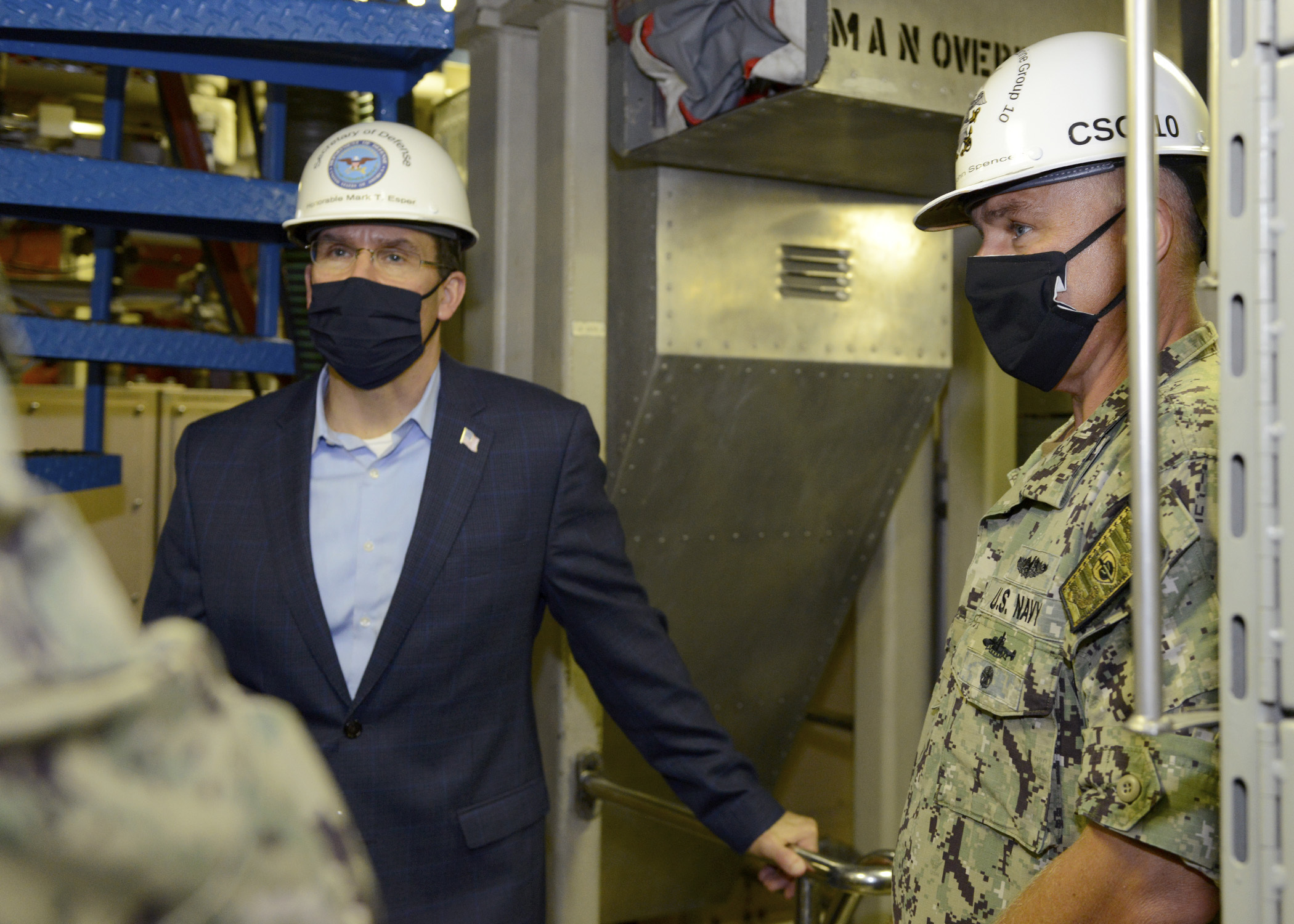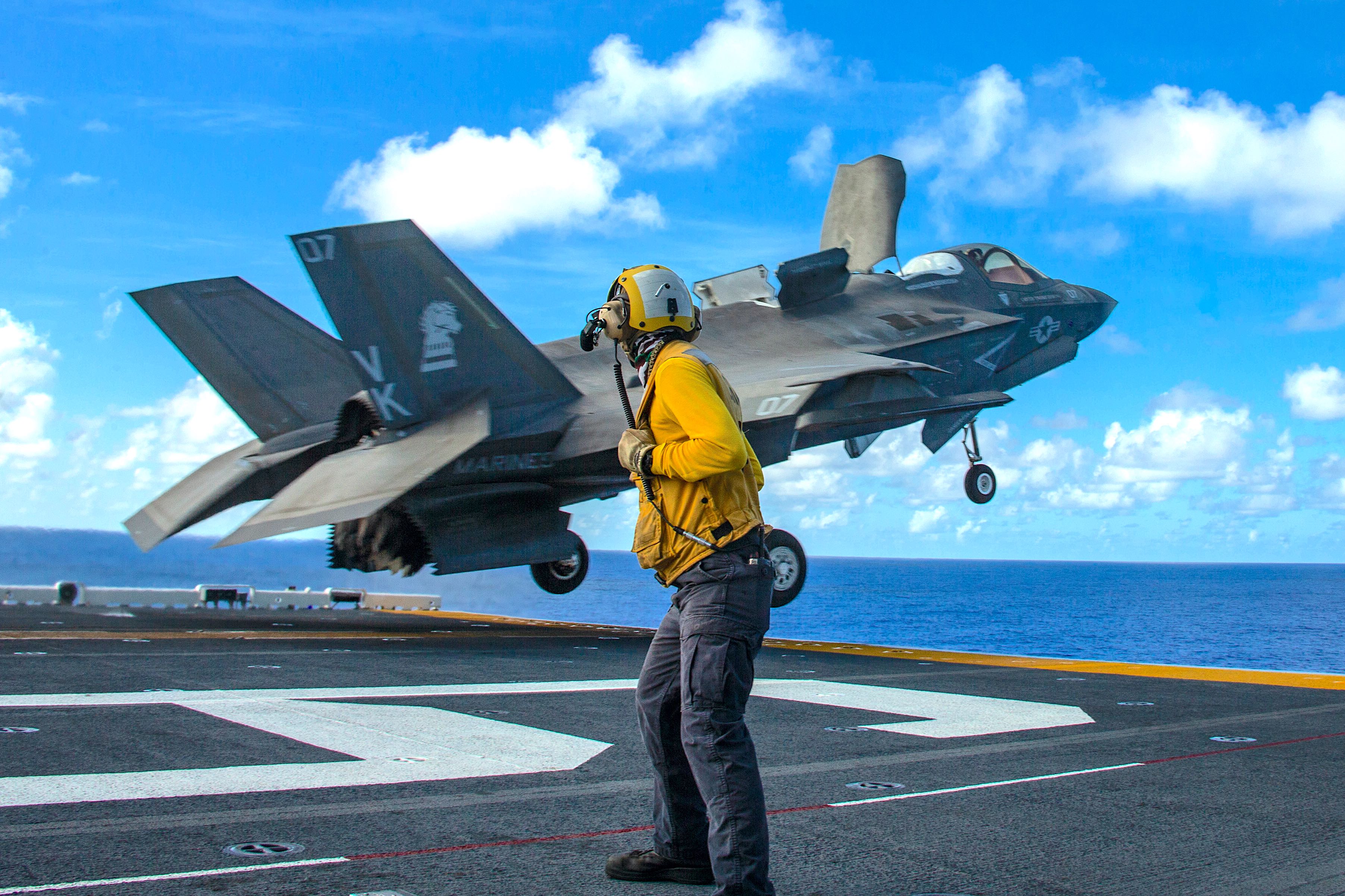
BALTIMORE, Md. – The maritime services are poised to release several documents in the next few weeks that will outline a new path forward for the Navy, Marine Corps and Coast Guard under the National Defense Strategy, Navy Secretary Braithwaite previewed on Wednesday.
The secretary told USNI News that he’s done a deep-dive into the budget and found tens of billions of dollars in cuts that will help fund the Pentagon’s 500-ship plan announced this week. He also said the chief of naval operations would be releasing a Navigation Plan soon and that the Tri-Service Maritime Strategy was also on its way out soon, both of which would shed more light on how today’s fleet would operate around the globe and what to expect from the bigger fleet the Pentagon has agreed to fund.
Defense Secretary Mark Esper said Tuesday while outlining the new Battle Force 2045 fleet plan – which will reach 355 conventional ships by 2035 and about 500 manned and unmanned ships by 2045 – that the Navy did some serious work on its own budget to find savings, which led him to reward the Navy with a greater share of the Defense Department budget pie.
“We have charted a credible path to reaching 355 ships that works within real-world budget constraints. Through its own reviews and reforms, the Navy did good work these past several months freeing up funds in the coming years for the building of new ships. The Navy must continue these initiatives; they are essential to ensuring an adequate shipbuilding account for the task ahead,” Esper said during the Battle Force 2045 rollout.
“Given the serious reform efforts put forward by the Secretary of the Navy and the Chief of Naval Operations – and their commitment to continue them – I agreed to provide additional funding from across the DoD enterprise, funding that was harvested from ongoing reform efforts, such as Combatant Command reviews, Fourth Estate reforms, and other initiatives. Together, these additional funding streams will increase the shipbuilding account to 13 percent within the Navy’s topline, matching the average percentage spent for new ships during President Reagan’s buildup in the 1980s.”
Braithwaite spoke to two reporters today after filming a video announcing the name of the guided-missile frigate class, which will be the Constellation class.
Asked by USNI News to elaborate on the savings he identified, he said that the prospect of greater funding to support shipbuilding “was the carrot that [Esper] put out there. So as a businessman, that’s a great incentive: you give a business unit the ability to make their objectives for the quarter, for the year, whatever, and if they go after that and they’re able to accrue those kind of sales or savings, then you reward them by ensuring that they have more resources to do even greater work. So Secretary Esper put that marker on the table and challenged us. And the team that we have is fantastic, led by several of our assistant secretaries; they just did a fantastic job.”

He said the specifics would be released shortly, “but I can tell you that … building more ships is the bottom line.”
“We’ve got to be able to get from where we are today at about 300 up to 355 , and with the future naval force structure, the Battle Force 2045, with unmanned capability takes us even farther beyond that. But you’ve got to be able to pay for that, so we looked across the entire spectrum of everything in the Navy – in fact, I just met with the chief of chaplains today, and everybody was affected to some degree by some of the reprogramming, the reorganization. There’s still more coming. You’re going to see some pretty significant announcements in the next few days.”
In addition to his budget announcements, he also heading towards public release are the Tri-Service Maritime Strategy, which will “lay out what the focus of the Navy and Marine Corps and Coast Guard team is in the maritime space, married up to the [National Defense Strategy],” and the CNO’s Navigation Plan, which will be the Navy’s equivalent of the Commandant’s Planning Guidance released last summer that overhauled how the Marines intend to fight and what they’ll need to buy to be successful in that fight.
Braithwaite later added that the budget, the forthcoming shipbuilding plan, the tri-service strategy and the CNO plan – plus an Arctic Strategy he’s also working on – “are all interwoven with one another” and will reshape where the services are headed and what role they’ll play on a global stage.
Asked how his results compared to what Acting Secretary Thomas Modly had tried to do this spring, announcing a drive to find $40 billion across the next five fiscal years to redirect towards shipbuilding, Braithwaite said, “I got way beyond that.”
“Everybody had to find savings. There was pretty much nobody who was let off the hook. Because as I found in business, you can always make something more efficient and more effective. There’s always two percent, five percent. You know, I had some of the components within the overall department come to me and say, I know I can find 20-percent savings. They literally offered that up,” the secretary said.
“So it was a lot of work, but it was a real reflection on the professionalism of everybody wanting to do their part to get to that 355-ship or bigger navy.”

Capturing attention during the rollout of the Battle Force 2045 plan is the role of the aircraft carrier. Esper said during his speech that more work was needed to more clearly identify how large the carrier fleet would be, but he expects between eight and 11 nuclear-powered supercarriers as well as a fleet of about half a dozen light carriers to supplement them.
“I’m a former naval aviator, so I’m a pro naval aviation guy. So right away, some of the people in the trade press jumped onboard fewer carriers when Secretary Esper mentioned that yesterday. We’re looking at a range, and we’re going to determine what the threat is, what the requirement is, and then be able to build to that number. I fully believe that that number will be pretty close to where it is today,” Braithwaite said today, referring to the 11 carriers currently in the fleet.
“And we’re going to augment that by doing even more work on the CVL. As you can tell, you’re aboard USS Constellation – I’m a big history guy, and the United States Navy won World War II on the backs of our light carriers, in addition to a lot of other resources, but our CVLs really provided that quantity that was so important. So if we can do the same thing and look to build a CVL at one-third, one-half the cost of what we build a CVN for, still having the CVNs which are going to serve in the fleet for the next 50-plus years, and complement that with CVLs – and, again, we don’t know what the sixth-generation aircraft aboard the deck is going to be, we may be able to get more aboard the light carriers and have the same kind of strike capability. So there’s a lot of unknowns, but there’s a lot of potential and a lot of excitement in going after that. So I think it’s going to be a really great story.
“If anything comes out of this, what you should look at is the Navy’s going to grow,” he continued.
“This is the first time since the Reagan era, and my mentor, John Lehman, who I just had lunch with a couple weeks ago, that we are building a navy that’s going to be this capable and therefore be able to project our interests around the globe on behalf of our allies and our partners.”





